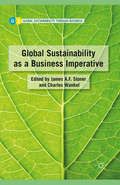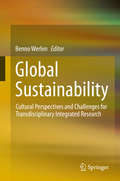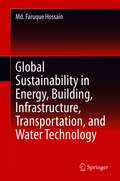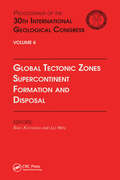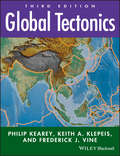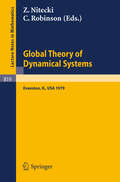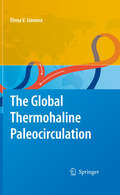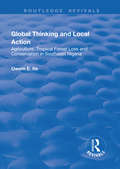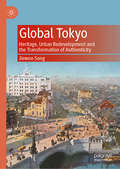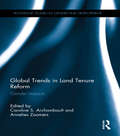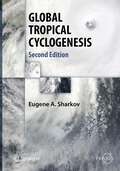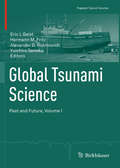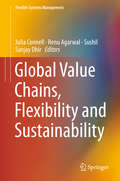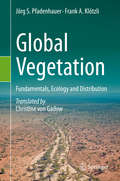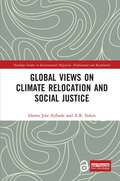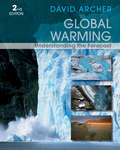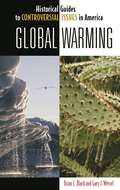- Table View
- List View
Global Sustainability as a Business Imperative (Global Sustainability Through Business)
by James A. F. Stoner & Charles Wankel Charles WankelThis first volume in the series addresses the pressing need to align business practices with the requirements of a sustainable world. Delivering new models for conducting business, implications of undertaking new approaches, and ways businesses are transforming and being transformed by their environments.
Global Sustainability, Cultural Perspectives and Challenges for Transdisciplinary Integrated Research
by Benno WerlenThis book offers new perspectives of transdisciplinary research, in methodological as well as theoretical respects. It provides insights in the two-fold bio-physical and the socio-cultural global embeddedness of local living conditions on the basis of selected empirical studies from Latin America, Asia, Africa, Australia and Europe. The theoretical foundations of ecological research and sustainability policies were developed at the end of the nineteenth century. They are largely based on investigations of living spaces and the evolution and differentiation of varied life forms. This perspective is embedded in the practical and theoretical European problem situations of the past and lacks social and cultural differentiation. The transformation of spatial and natural relations as a result of the globalization process is so radical that new theories are needed to solve 21st century ecological problems. Moreover, in view of the lack of an ontologically sound and promising strategy for transdisciplinary problem solving, as well as an acceptable consideration of the power of cultural schemas relating to natural living’s interpretations, there is a strong need to focus on sustainable social practices, habits and routines, rather than on predominantly living spaces or eco-topes. This book elaborates on the transdisciplinary approach by reflecting on the theoretical heritage and a global perspective of sustainability, by focusing on the primary role of a social approach in sustainability research and by putting emphasis on cultural dimension of sustainability. It postulates that global sustainability is grounded in a global understanding of our everyday activities.
Global Sustainability in Energy, Building, Infrastructure, Transportation, and Water Technology
by Md. Faruque HossainThis book focuses on holistic approaches to sustainability in all sectors of building, infrastructure, and energy to achieve a best-balanced global energy, building, infrastructure, transportation, and water technology (EBITW) system using a series of innovative research and implementation solutions. The goal of this book is to define the context for proactive consideration of scientific theories and practical technical applications of sustainable development, following main seven themes: Renewable Energy Technology, Advanced Building Design Technology, Innovative Infrastructure and Transportation Engineering, Clean Water and Sanitation, Sustainable Urban and Rural Development, Clean Environment, and Sustainable Planet; which are very much interconnected to secure the global equilibrium. The book is prepared for a wide audience including researchers, field engineers, and students.
Global Tectonic Zones, Supercontinent Formation and Disposal: Proceedings of the 30th International Geological Congress, Volume 6
by Xiao Xuchang and Liu HefuThis book is a collection of papers presented in the 30th International Geological Congress, held in Beijing, on global tectonic zones supercontinent formation and disposal. The papers deal with topics on tectonic framework, and petrology and geochemistry variations of Asian regions.
Global Tectonic Zones, Supercontinent Formation and Disposal: Proceedings of the 30th International Geological Congress, Volume 6
by Xiao Xuchang Liu HefuThis book is a collection of papers presented in the 30th International Geological Congress, held in Beijing, on global tectonic zones supercontinent formation and disposal. The papers deal with topics on tectonic framework, and petrology and geochemistry variations of Asian regions.
Global Tectonics
by Philip Kearey Keith A. Klepeis Frederick J. VineThe third edition of this widely acclaimed textbook provides a comprehensive introduction to all aspects of global tectonics, and includes major revisions to reflect the most significant recent advances in the field. A fully revised third edition of this highly acclaimed text written by eminent authors including one of the pioneers of plate tectonic theory Major revisions to this new edition reflect the most significant recent advances in the field, including new and expanded chapters on Precambrian tectonics and the supercontinent cycle and the implications of plate tectonics for environmental change Combines a historical approach with process science to provide a careful balance between geological and geophysical material in both continental and oceanic regimes Dedicated website available at www.blackwellpublishing.com/kearey/
Global Tectonics
by Philip Kearey Keith A. Klepeis Frederick J. VineThe third edition of this widely acclaimed textbook provides a comprehensive introduction to all aspects of global tectonics, and includes major revisions to reflect the most significant recent advances in the field. A fully revised third edition of this highly acclaimed text written by eminent authors including one of the pioneers of plate tectonic theory Major revisions to this new edition reflect the most significant recent advances in the field, including new and expanded chapters on Precambrian tectonics and the supercontinent cycle and the implications of plate tectonics for environmental change Combines a historical approach with process science to provide a careful balance between geological and geophysical material in both continental and oceanic regimes Dedicated website available at www.blackwellpublishing.com/kearey/
Global Temperature and Carbon Emissions (large print)
by RnibThis page shows a labelled line graph. There is a locator dot shown, which will be at the top left, when the image is the correct way up. The Y-axis on the left of the page is temperature in degrees Centigrade. It is marked every 0.2 degrees and labelled at 13 and 14 degrees. The X-axis at the bottom of the page is time in years. It is marked every 20 years and labelled every 40 years. The Y-axis on the right of the page is carbon dioxide in billions of tonnes. It is marked every 50 billion tonnes and labelled every 100 billion tonnes. The temperature data line is solid (red on large print) and the carbon dioxide data line is dotted (black on large print). Both lines start in the bottom left and go up and across to the top right.
Global Temperature and Carbon Emissions (UEB contracted)
by RnibThis page shows a labelled line graph. There is a locator dot shown, which will be at the top left, when the image is the correct way up. The Y-axis on the left of the page is temperature in degrees Centigrade. It is marked every 0.2 degrees and labelled at 13 and 14 degrees. The X-axis at the bottom of the page is time in years. It is marked every 20 years and labelled every 40 years. The Y-axis on the right of the page is carbon dioxide in billions of tonnes. It is marked every 50 billion tonnes and labelled every 100 billion tonnes. The temperature data line is solid (red on large print) and the carbon dioxide data line is dotted (black on large print). Both lines start in the bottom left and go up and across to the top right.
Global Temperature and Carbon Emissions (UEB uncontracted)
by RnibThis page shows a labelled line graph. There is a locator dot shown, which will be at the top left, when the image is the correct way up. The Y-axis on the left of the page is temperature in degrees Centigrade. It is marked every 0.2 degrees and labelled at 13 and 14 degrees. The X-axis at the bottom of the page is time in years. It is marked every 20 years and labelled every 40 years. The Y-axis on the right of the page is carbon dioxide in billions of tonnes. It is marked every 50 billion tonnes and labelled every 100 billion tonnes. The temperature data line is solid (red on large print) and the carbon dioxide data line is dotted (black on large print). Both lines start in the bottom left and go up and across to the top right.
Global Theory of Dynamical Systems: Proceedings of an International Conference Held at Northwestern University, Evanston, Illinois, June 18-22, 1979 (Lecture Notes in Mathematics #819)
by Z. Nitecki C. RobinsonThe Global Thermohaline Paleocirculation
by Elena IvanovaOriginally published in Russian in 2006, this is the first English translation of this important book on paleoceanography and paleoclimatology. Its initial publication was followed by a surge of interest in this subject prompting the author to revise and translate her original work. In the book, she successfully summarizes her own research over recent years and compiles an overview of up-to-date knowledge on past ocean circulation. The key topics include: - Modern thermohaline circulation and main stages of its development during the Cenozoic - Methods and proxies of paleoceanographic reconstruction - Variability of the meridional overturning circulation and paleoceanographic events in the North Atlantic during the last climatic cycle - Influence of the global thermohaline circulation on paleoceanographic events in the Eurasian Arctic seas, the Northern Indian Ocean, and the South China Sea - The role of the thermohaline circulation in global teleconnections in the Antarctic, Eurasian Arctic, northern Pacific and low latitudes Indo-Pacific. Comprehensive investigation of hundreds of international publications and her own results, convinced the author that the global thermohaline circulation controls the remote teleconnections on millennial-scale and partly on centennial-scale, while short-term climate signals are mainly transferred by the atmosphere. This revised and extended English edition provides the latest unpublished data, new figures and modeling results. The extensive reference list contains more than 100 publications and 140 new references.
Global Thinking and Local Action: Agriculture, Tropical Forest Loss and Conservation in Southeast Nigeria (Routledge Revivals)
by Uwem E. IteThis title was first published in 2001. Based on extensive local field research undertaken in and around the Cross River National Park in Nigeria, this book provides a socio-economic study of the tensions between agriculture and nature conservation. Taking a ’bottom-up’ approach and focussing on the farm household and the dynamics of forest farming at household level, it brings together a wealth of new information on the subject of tropical forestry, the causes and dynamics of tropical rain forest loss and the problematic relations between conservation authorities in National Parks and local people. Its conclusions raise important questions about practical ways forward in the development of such areas.
Global Thinking and Local Action: Agriculture, Tropical Forest Loss and Conservation in Southeast Nigeria (Routledge Revivals)
by Uwem E. IteThis title was first published in 2001. Based on extensive local field research undertaken in and around the Cross River National Park in Nigeria, this book provides a socio-economic study of the tensions between agriculture and nature conservation. Taking a ’bottom-up’ approach and focussing on the farm household and the dynamics of forest farming at household level, it brings together a wealth of new information on the subject of tropical forestry, the causes and dynamics of tropical rain forest loss and the problematic relations between conservation authorities in National Parks and local people. Its conclusions raise important questions about practical ways forward in the development of such areas.
Global Tokyo: Heritage, Urban Redevelopment and the Transformation of Authenticity
by Jiewon SongThis book examines heritage-led regeneration and decision-making processes in Tokyo’s urban centres of Nihonbashi and Marunouchi. Detailing some of the city’s most prominent and recent redevelopment projects, Jiewon Song recognizes key institutions and actors; their collective actions as placemakers; and how they project the authenticity of urban places in planning processes. Song argues that heritage-led regeneration tends to monopolize authenticity by weakening the visibility of other cultural and historic qualities in urban places. Authenticity consequently turns into a singular entity leading to the homogenization of urban places. As cities increasingly seek authenticity in the urban age, nation-states initiate top-down processes to achieve such ends, interweaving nationalism and national narratives into placemaking practices. In this fashion, Song challenges existing scholarship on urban conservation, global cities and the notion of authenticity.
Global Trends in Land Tenure Reform: Gender Impacts (Routledge ISS Gender, Sexuality and Development Studies)
by Caroline S. Archambault Annelies ZoomersThis book explores the gendered dimensions of recent land governance transformations across the globe in the wake of unprecedented pressures on land and natural resources. These complex contemporary forces are reconfiguring livelihoods and impacting women’s positions, their tenure security and well-being, and that of their families. Bringing together fourteen empirical community case studies from around the world, the book examines governance transformations of land and land-based resources resulting from four major processes of tenure change: commercial land based investments, the formalization of customary tenure, the privatization of communal lands, and post-conflict resettlement and redistribution reforms. Each contribution carefully analyses the gendered dimensions of these transformations, exploring both the gender impact of the land tenure reforms and the social and political economy within which these reforms materialize. The cases provide important insights for decision makers to better promote and design an effective gender lens into land tenure reforms and natural resource management policies. This book will be of great interest to researchers engaging with land and natural resource management issues from a wide variety of disciplines, including anthropology, sociology, development studies, and political science, as well as policy makers, practitioners, and activists concerned with environment, development, and social equity.
Global Trends in Land Tenure Reform: Gender Impacts (Routledge ISS Gender, Sexuality and Development Studies)
by Caroline S. Archambault Annelies ZoomersThis book explores the gendered dimensions of recent land governance transformations across the globe in the wake of unprecedented pressures on land and natural resources. These complex contemporary forces are reconfiguring livelihoods and impacting women’s positions, their tenure security and well-being, and that of their families. Bringing together fourteen empirical community case studies from around the world, the book examines governance transformations of land and land-based resources resulting from four major processes of tenure change: commercial land based investments, the formalization of customary tenure, the privatization of communal lands, and post-conflict resettlement and redistribution reforms. Each contribution carefully analyses the gendered dimensions of these transformations, exploring both the gender impact of the land tenure reforms and the social and political economy within which these reforms materialize. The cases provide important insights for decision makers to better promote and design an effective gender lens into land tenure reforms and natural resource management policies. This book will be of great interest to researchers engaging with land and natural resource management issues from a wide variety of disciplines, including anthropology, sociology, development studies, and political science, as well as policy makers, practitioners, and activists concerned with environment, development, and social equity.
GLOBAL TROPICAL CYCLOGENESIS (Springer Praxis Books)
by Eugene A. SharkovCyclogenesis research is a central issue of meteorology and climatology. This book gives a deep specific view and fundamentally and effectively contributes to the discussion of the problem. It treats cyclogenisis as a stochastic process in a very fundamental way. Since the publication of the first edition of Global Tropical Cyclogenesis in 2001, a number of important scientific results has been obtained using methods and techniques proposed in that first edition. There is therefore a great need for a revised 2nd edition of this book. It is based on scientific findings from the performance of satellite data processing and a series of scientific marine expeditions to the tropics as part of major Russian Science Academy research projects. Professor Eugene A. Sharkov has proposed the main approaches, experimental techniques and theoretical explanations for many scientific findings as well as new methods of satellite processing. He is recognized as a leading scientist in the field of microwave remote sensing of terrestrial surfaces and atmosphere and in nonlinear geophysics (origination and evolution of atmospheric catastrophes) and has published around 100 scientific works on the problems of global tropical cyclogenesis structure and evolution.
Global Tsunami Science: Past and Future, Volume I (Pageoph Topical Volumes)
by Eric L Geist Hermann M. Fritz Alexander B. Rabinovich Yuichiro TaniokaTsunami science has evolved significantly since the occurrence of two of the most destructive natural disasters in recent times: the 26 December 2004 Sumatra tsunami that killed about 230,000 people along the coasts of 14 countries in the Indian Ocean and the 11 March 2011 Tohoku (Great East Japan) tsunami that killed almost 20,000 people and destroyed the Fukushima Daiichi nuclear power plant. As a result of these and many other destructive tsunamis that have occurred over just the last decade, scientists from around the world have come together to engage in tsunami research. The global community of researchers has also expanded by discipline, adapting advances in other sciences to study all aspects of tsunami hydrodynamics, detection, generation, and probability of occurrence. The papers presented in this first of two topical volumes of Pure and Applied Geophysics reflect the state of tsunami science during this time. Nine papers examine various aspects of tsunami hazard and risk assessment. Five papers present new methods for tsunami warning and detection and six other papers describe new methods for understanding tsunami hydrodynamics. The final five papers of the volume describe tsunamis generated by non-seismic sources and important case studies. Collectively, this volume highlights contemporary trends in global tsunami science, both fundamental and applied toward hazard assessment and mitigation. The volume is of interest to scientists and practitioners involved in all aspects of tsunamis from source processes to coastal impacts. Postgraduate students in geophysics, oceanography and coastal engineering – as well as students in the broader geosciences, civil and environmental engineering – will also find the book to be a valuable resource, as it combines recent case studies with advances in tsunami science and natural hazards mitigation.
Global Value Chains, Flexibility and Sustainability (Flexible Systems Management)
by Julia Connell Renu Agarwal Sushil Sanjay DhirThis book provides a conceptual framework of global value chains, flexibility and sustainability, supported by research projects, case applications and models in various related areas organized into three parts. In the first part of the book, various authors discuss how to improve the efficiency and effectiveness of global value chains through various types of analyses. While the focus is on cluster management, and mergers and joint ventures, the legal aspects of control and liability concerning the integration of value chains, is also examined in one of the contributions. The second part includes chapters concerning ‘Strategy and Flexibility’. Strategies concern topics such as inventory management, talent management, strategic alignment, decision making, behavioural change and HR systems. The third and final part of the volume concerns the topic of ‘Sustainability’, wherein the contributions focus on various initiatives intended to promote sustainability across respective value chains bearing in mind the concept of flexibility. The book is a valuable resource for a varied audience, ranging from management students and researchers, to practicing business managers, as well as for professional institutions, consultants, and corporate organizations.
Global Vegetation: Fundamentals, Ecology and Distribution
by Jörg S. Pfadenhauer Frank A. KlötzliThis up-to-date textbook of global vegetation ecology, which comprises the current state of knowledge, is long overdue and much-needed. It is a translation of the textbook “Vegetation der Erde” (Springer-Spektrum, Heidelberg). A short introductory chapter deals with the fundamentals of vegetation ecology that are of importance for the delimitation and characterization of the global vegetation presented in this book (chorology, evolution of plants, physiognomic and structural characteristics, phytodiversity and the human impact on it as well as general terminology concerning both plant growth forms and on vegetation structure types). In the following chapters the zonal and azonal vegetation from the tropics to the polar regions including high mountains is described and discussed. The main focus is on the characterization of interactions between the spatial location of plants and plant communities on the one hand and site conditions, historic and genetic processes, spatial and temporal patterns, ecophysiology and anthropogenic influences on the other hand. Additional information on specific topics is provided in 51 boxes.
Global Views on Climate Relocation and Social Justice: Navigating Retreat (Routledge Studies in Environmental Migration, Displacement and Resettlement)
by Idowu Jola Ajibade A. R. SidersThis edited volume advances our understanding of climate relocation (or planned retreat), an emerging topic in the fields of climate adaptation and hazard risk, and provides a platform for alternative voices and views on the subject. As the effects of climate change become more severe and widespread, there is a growing conversation about when, where and how people will move. Climate relocation is a controversial adaptation strategy, yet the process can also offer opportunity and hope. This collection grapples with the environmental and social justice dimensions from multiple perspectives, with cases drawn from Africa, Asia, Australia, Oceania, South America, and North America. The contributions throughout present unique perspectives, including community organizations, adaptation practitioners, geographers, lawyers, and landscape architects, reflecting on the potential harms and opportunities of climate-induced relocation. Works of art, photos, and quotes from flood survivors are also included, placed between sections to remind the reader of the human element in the adaptation debate. Blending art – photography, poetry, sculpture – with practical reflections and scholarly analyses, this volume provides new insights on a debate that touches us all: how we will live in the future and where? Challenging readers’ pre-conceptions about planned retreat by juxtaposing different disciplines, lenses and media, this book will be of great interest to students and scholars of climate change, environmental migration and displacement, and environmental justice and equity.
Global Views on Climate Relocation and Social Justice: Navigating Retreat (Routledge Studies in Environmental Migration, Displacement and Resettlement)
by Idowu Jola Ajibade A. R. SidersThis edited volume advances our understanding of climate relocation (or planned retreat), an emerging topic in the fields of climate adaptation and hazard risk, and provides a platform for alternative voices and views on the subject. As the effects of climate change become more severe and widespread, there is a growing conversation about when, where and how people will move. Climate relocation is a controversial adaptation strategy, yet the process can also offer opportunity and hope. This collection grapples with the environmental and social justice dimensions from multiple perspectives, with cases drawn from Africa, Asia, Australia, Oceania, South America, and North America. The contributions throughout present unique perspectives, including community organizations, adaptation practitioners, geographers, lawyers, and landscape architects, reflecting on the potential harms and opportunities of climate-induced relocation. Works of art, photos, and quotes from flood survivors are also included, placed between sections to remind the reader of the human element in the adaptation debate. Blending art – photography, poetry, sculpture – with practical reflections and scholarly analyses, this volume provides new insights on a debate that touches us all: how we will live in the future and where? Challenging readers’ pre-conceptions about planned retreat by juxtaposing different disciplines, lenses and media, this book will be of great interest to students and scholars of climate change, environmental migration and displacement, and environmental justice and equity.
Global Warming: Understanding the Forecast
by David ArcherBased on the author's highly successful undergraduate course taught at the University of Chicago, Global Warming presents the processes of climate change and climate stability. Drawing on a wide range of disciplines, this Second Edition not only summarizes scientific evidence, but also presents economic and political issues related to global warming.
Global Warming (Historical Guides to Controversial Issues in America)
by Brian C. Black Gary J. WeiselTracing scientific ideas about the structure of Earth, Global Warming creates an intellectual portrait of the shifts in thinking that have led to the current controversy, enabling readers to make up their own minds on this important issue.Global Warming takes one of the hot-button issues of our time and surveys it in historical context, creating an intellectual portrait of the multi-century shifts in thinking that have led to gradual acceptance of the concept. The book summarizes pertinent aspects of geology, earth science, and climate science in easy-to-read terms. It then frames this background in terms of cultural and social shifts, including the Industrial Revolution, conspicuous consumption, and modern environmentalism. In addition, a study of the ebb and flow of cultural and political reception relates the issue to religious and social ideas.The information presented here will enable the reader to understand the scientific case stating that human activity has caused an unprecedented warming in the late 20th and early 21st centuries. Technical and political objections to this thesis are also covered, so that readers may form their own opinions on this critical subject.
